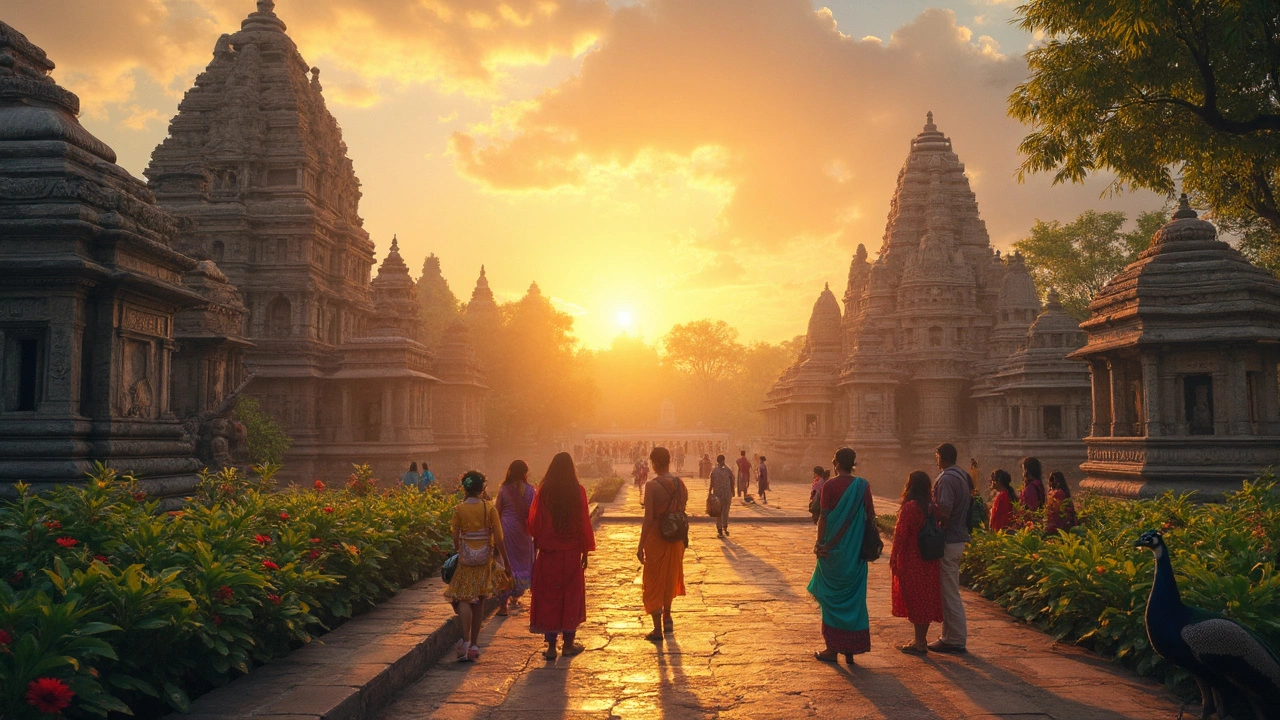Discovering India's Most Beautiful Architectural Masterpieces
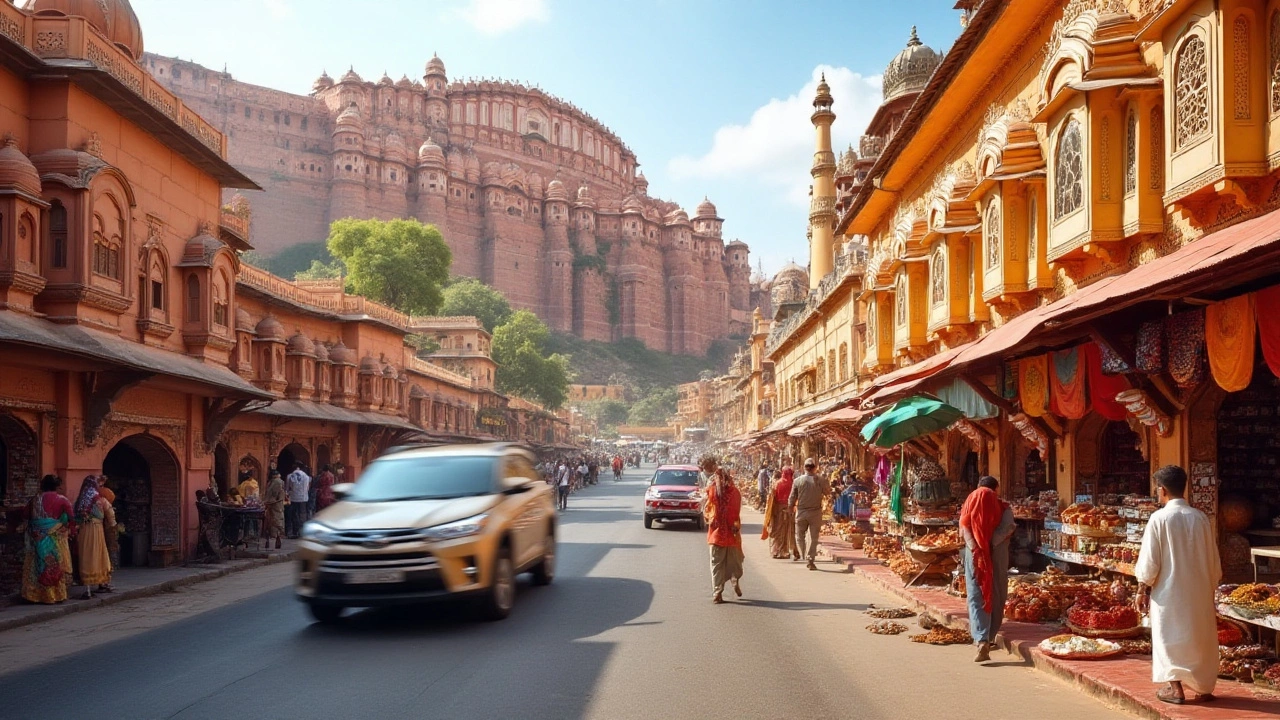
India's architectural landscape is a journey through time and culture. From ornate palaces to timeless forts, the country is a testament to human creativity and diversity. Every city has its own story to tell, molded by dynasties, colonials, and innovators who left their marks in stone and bricks.
Jaipur, known affectionately as the Pink City, is a feast for the eyes with its rose-hued buildings and royal palaces. Agra, while synonymous with the Taj Mahal, offers much more, with its legacy of Mughal architecture inviting explorations beyond its famous marble wonder. In Mumbai, the skyline is a fusion of history and modernity, where British Raj-era buildings coexist with urban skyscrapers, showing off its eclectic charm.
Delhi stands as a living museum of architectural styles, from centuries-old forts and mosques to cutting-edge modernity. Each city in India presents a distinct architectural narrative, inviting travelers to uncover layers of history, culture, and artistry embedded in the urban fabric. In this exploration, discover the cities that house India's most beautiful architecture, and understand why they continue to captivate architects, historians, and travelers alike.
- Jaipur: The Pink City's Regal Grandeur
- Agra: Beyond the Taj Mahal
- Mumbai: Colonial Marvels and Modern Wonders
- Delhi: A Tapestry of Ancient and Contemporary
Jaipur: The Pink City's Regal Grandeur
Jaipur, the capital of Rajasthan, affectionately known as the Pink City, evokes an allure of regal magnificence that is reflected in its stunning India architecture. This vibrant city was founded in the 18th century by Maharaja Sawai Jai Singh II, who envisioned a city that combined both architectural splendor and strategic planning. His dreams paved the way for one of India’s most enchanting urban landscapes, painted in hues of rose for a royal welcome. The city follows principles of Vastu Shastra, which means harmony between buildings and nature — an ancient architectural guideline. The wide boulevards, airy gardens, and stately palaces constructed here highlight the Maharaja’s ambition for elegance mixed with functionality.
The City Palace stands proud at the city center, an exquisite blend of Rajput and Mughal architecture. Wander through its complex of courtyards, gardens, and unique structures where each turn narrates tales of yesteryears. Notably, the palace’s Chandra Mahal and Mubarak Mahal are architectural triumphs that exude historic charm. The impressive museum within houses an extensive array of royal costumes, weaponry, and miniature paintings, offering glimpses into the opulent lives of Jaipur’s royalty.
One cannot speak of Jaipur without mentioning the iconic Hawa Mahal, or ‘Palace of Winds’. Designed to allow royal women to observe street festivities without being seen, it features 953 small windows, called jharokhas, adorned with intricate latticework. This architectural marvel seamlessly blends aesthetics with clever engineering, boasting an open structure facilitating a passage of breeze, hence its name. ‘The quintessence of Jaipur's architectural heritage exemplifies how innovation met tradition,’ states noted historian William Dalrymple.
Exploration of the Amer Fort, perched high on a hill overlooking the Maota Lake, provides a majestic view of Jaipur’s ancient might. Erected in red sandstone and marble, this fort is a brilliant example of how builders of the past seamlessly woven grand Mughal styles with traditional Rajput elements. Visitors are especially captivated by the Sheesh Mahal, or the Mirror Palace, where thousands of small mirrors cover the walls, reflecting light to create a twinkling starlit effect.
Delving into the architectural legacy of Jaipur, it becomes evident that every element, from temples exuding spirituality to gardens offering tranquility, contributes to its allure as a city of unmatched beauty. The Albert Hall Museum stands as an example of Indo-Saracenic architecture, embracing the fusion of Indian, Islamic, and Western influences. Strolling through its corridors, one finds a splendid compilation of Rajasthan’s rich artistic heritage.
For the modern visitor, Jaipur offers a unique experience where tradition fuses with contemporary living. As you explore its charming streets, lined with marketplaces teeming with vibrant textiles and handcrafted jewels, Jaipur undoubtedly presents itself as a living museum. Those who visit are constantly amazed by the seamless blend of past elegance with present vibrancy, making it ever deserving of international acclaim for its architectural brilliance and richly woven tapestry of history.
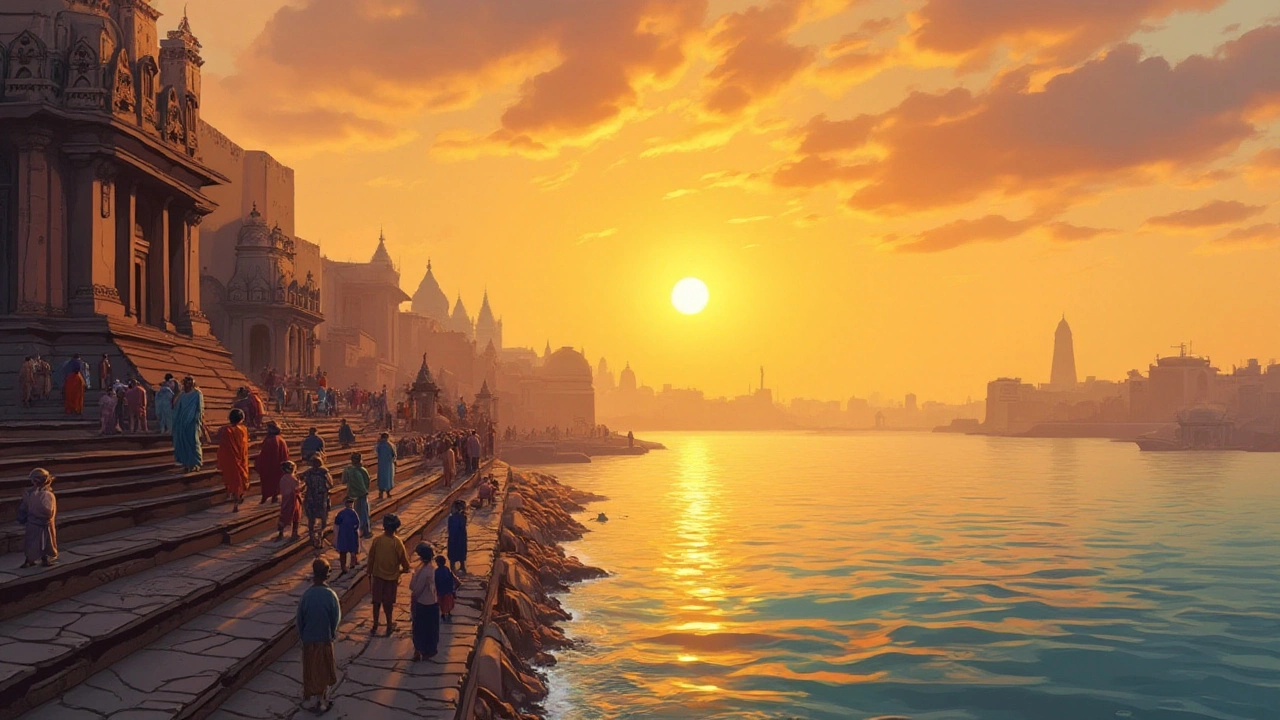
Agra: Beyond the Taj Mahal
When many think of Agra, the image of the resplendent Taj Mahal immediately springs to mind—a masterpiece of Mughal architecture universally admired for its beauty. But to only associate Agra with this extraordinary mausoleum is to overlook a treasure trove of historical sites, each a witness to the grand era of Mughal rule. Agra, a city nestled on the banks of the Yamuna River, unfolds a rich tapestry of history with its labyrinthine alleys and grand boulevards, offering much more than the gleaming white marble of its most famous monument.
Agra Fort, a UNESCO World Heritage Site, stands less than three kilometers from the Taj Mahal and is an astonishing example of Mughal ingenuity. Constructed predominantly from red sandstone, this fort is not merely a defensive structure but a splendid imperial city. Designed by Emperor Akbar, it reflects a seamless blend of Islamic and Hindu architectural styles. The fort's walls, towering over 20 meters in height, stretch for approximately 2.5 kilometers, encompassing several magnificent palatial buildings. Within these robust fortifications lies the Diwan-i-Am—a hall of public audiences, the Diwan-i-Khas for private meetings, and the impressive Pearl Mosque, or Moti Masjid, which sparkles under the Indian sun.
Proceeding further along the city's historical journey, one arrives at the Tomb of Itimad-ud-Daulah, often referred to as the 'Baby Taj.' Drawing lesser crowds than its larger counterpart, this tomb is a jewel of intricate craftsmanship. Commissioned by Nur Jahan, the wife of Jahangir, in memory of her father, the monument is regarded as a significant precursor to the Taj Mahal. With precious inlay work and serene gardens, the Tomb of Itimad-ud-Daulah is a prototype of Mughal artistry and marks the first use of white marble in the region’s buildings.
More to Explore
For those seeking stories untold and paths less traveled, Mehtab Bagh, the moonlit garden, offers a unique perspective of the Taj Mahal. Located north across the Yamuna, this garden is a fascinating insight into Mughal landscaping techniques. Not only does it provide stunning views of the Taj Mahal at sunset, but it was also believed to be part of Shah Jahan's original design to create a series of gardens that mirror the mausoleum. Legend has infused Agra with countless stories, one such being the lore of the abandoned city of Fatehpur Sikri, which lies about 40 kilometers from Agra and serves as a window to the rich narrative tapestry of the Mughal dynasty.
As you traverse Agra, beyond the marble edifice famed across the globe, you'll unearth layers of history and artistry that speak volumes of the city's glorious past. Agra's architectural diversity offers every traveler a chance to experience eras gone by, allowing for a deeper connection to the fascinating trajectory of India's vast architectural heritage.
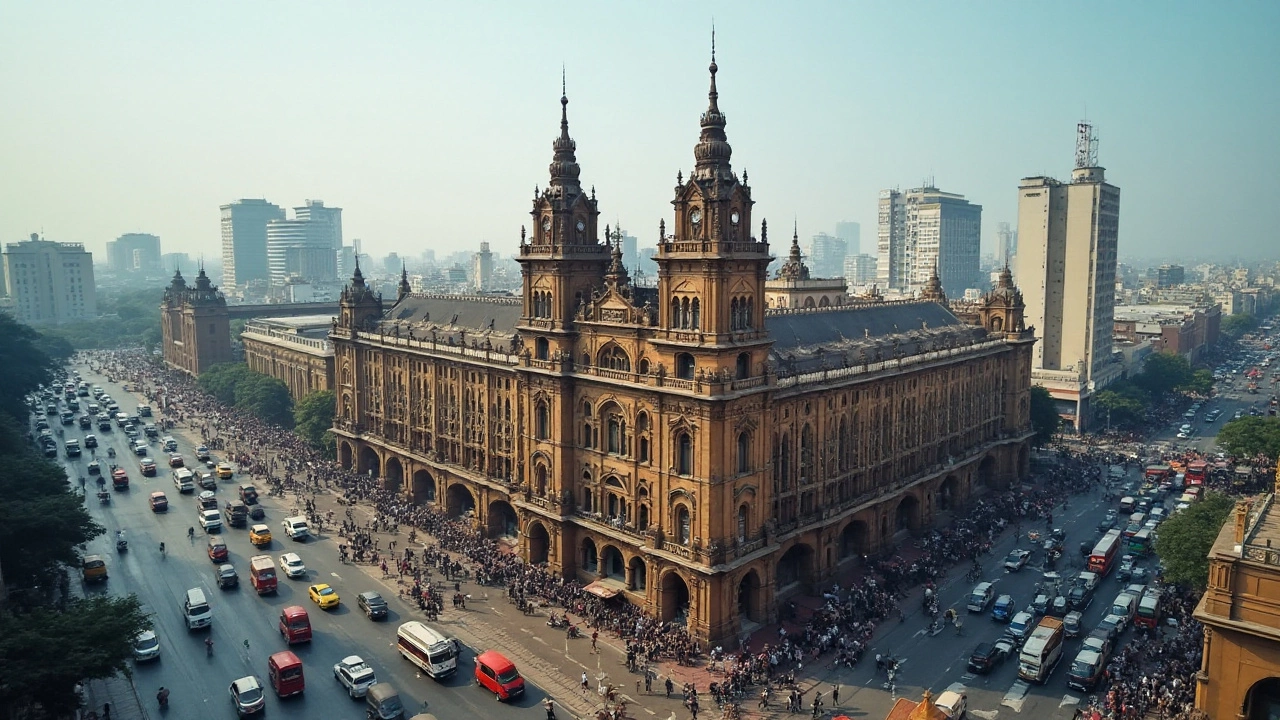
Mumbai: Colonial Marvels and Modern Wonders
Mumbai, often hailed as the heart of India’s financial prowess, is also a magnificent tapestry of history and modernity. Walking through its streets is like stepping into a time machine that ushers you from the colonial era straight into a futuristic world. The city's architecture speaks volumes of the days when it was a prized possession of the British Empire, as well as its present significance as a bustling metropolis. The juxtaposition of colonial marvels with ultramodern structures creates a skyline unlike any other—a testament to its dynamic spirit and architectural ingenuity.
No discussion about Mumbai's architecture is complete without mentioning the renowned Chhatrapati Shivaji Terminus, formerly known as Victoria Terminus. This UNESCO World Heritage Site is an epitome of Victorian Gothic architecture fused with Indian influences, showcasing elaborate stone carvings, stained glass windows, and ornate decorations. This railway station, buzzing with life, not only serves as a crucial transport hub but also as a symbol of Mumbai’s historical significance and aesthetic grandeur. It's said that when renowned architect Frederick William Stevens devised its plans, he was inspired by the St. Pancras Station in London, with an Indian twist.
"The Chhatrapati Shivaji Terminus is not just a railway station; it's a museum of architecture," remarked historian Rizwan Merchant during a lecture at the Mumbai Museum Symposium.
Adding to the list of colonial treasures is the iconic Gateway of India. This triumphal arch stands majestically overlooking the Arabian Sea, embodying the royal grandeur of the era it commemorates. Built to mark the visit of King George V and Queen Mary to India, its Indo-Saracenic style is a harmonious blend of Hindu and Muslim architectural elements. Its vicinity is perpetually alive with tourists and locals alike, marveling at its intricacies and capturing memories against its backdrop.
Beyond its historical jewels, Mumbai showcases an alluring array of modern architectural wonders. The city's ever-evolving skyline, punctuated by soaring skyscrapers like The Imperial Towers and the Antilia, reflects its meteoric climb as a global city. These structures are not merely feats of engineering but emblematic of Mumbai's journey towards cosmopolitanism and luxury. Antilia, for instance, although controversial for its opulence, stands as a symbol of modern Mumbai's endless aspirations and global stature. The melding of fashion technology within its architecture is indicative of how the city embraces innovation without shedding its historical roots.
Mumbai’s architecture is diversified not only in its styles but also in its purposes. The revered Haji Ali Dargah represents not only the religious diversity of the city but also demonstrates how architectural beauty can be a medium of spiritual solace. Located on an islet in the sea, it magically connects a spiritual journey with an architectural delight.
- Chhatrapati Shivaji Terminus - A UNESCO Heritage Site, blend of Gothic and Indian architecture.
- Gateway of India - Symbol of colonial triumph, Indo-Saracenic style.
- The Imperial Towers - Skyscrapers epitomizing modern luxury.
- Haji Ali Dargah - Spiritual and architectural harmony on the sea.
Mumbai's narrative is engraved in its very structures, making it a city where the old and new constantly converse and complement each other. Whether one walks beneath the colonial arches or gazes up at the glitzy high-rises, the city leaves an indelible mark with its architectural charm and cultural vibrancy. This is why Mumbai remains a core topic of interest for Indian architecture enthusiasts and travelers worldwide, weaving together epochs of history with threads of modernity.
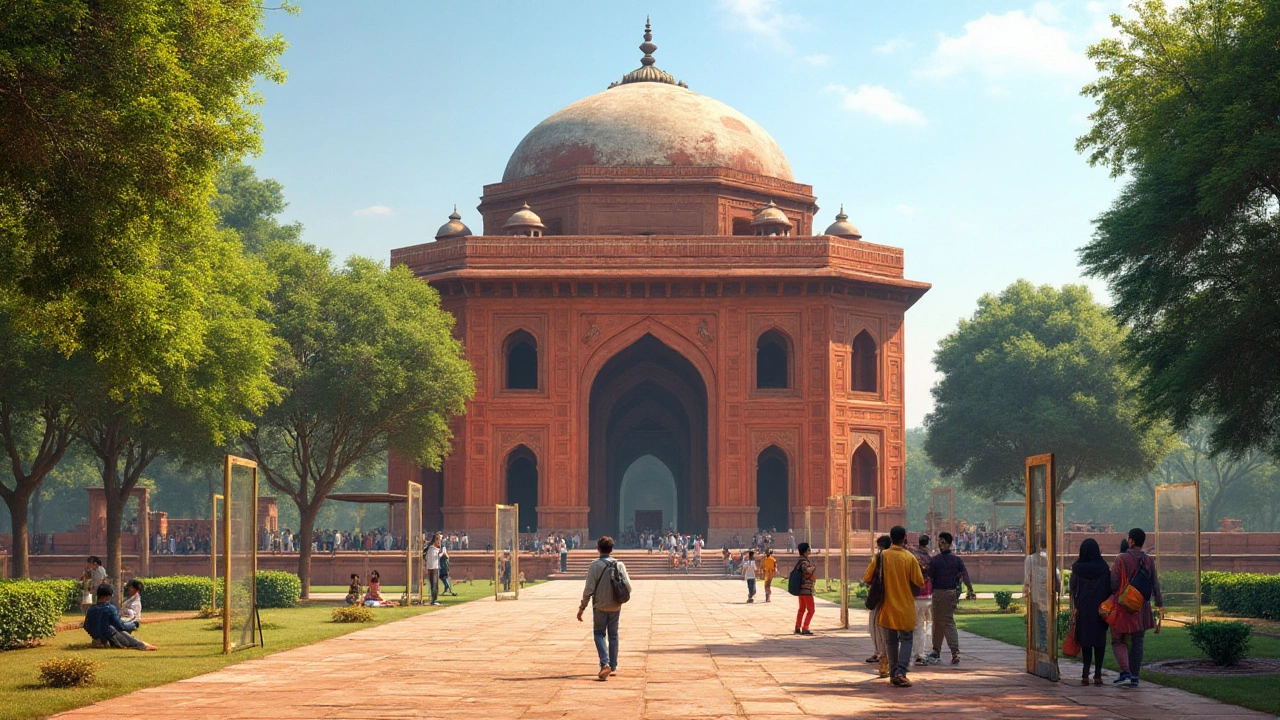
Delhi: A Tapestry of Ancient and Contemporary
Delhi, the heart of India, plays host to a magnificent blend of architectural eras that span centuries. From the remnants of the mighty Mughal emperors to the cutting-edge design of the modern capital, it is a city where every corner has whispers of history intertwined with the buzz of the future. Walking through Delhi is akin to leafing through the pages of a history book, with the architecture providing vivid illustrations and nuanced narratives. Among its most famous structures, the Red Fort, a sprawling red sandstone wonder, stands as a testament to the power and artistry of the Mughal empire. Its massive walls were built to keep the invaders out, yet today they beckon tourists from around the globe to step inside and be awestruck by its beauty and significance.
Not far from these bastions of the past, one finds the Lotus Temple, a symbol of harmony and serenity under the city's sky. Its modern architectural design has placed Delhi on the map for innovative contemporary architecture. Shaped like a lotus flower, its twenty-seven free-standing marble petals make it one of the most photographed buildings in the city. Just as intriguing, yet in stark contrast, is the Qutub Minar, the world's tallest brick minaret. The intricate carvings on its surface narrate tales of conquests and aspirations, allowing visitors to gaze upon the stone and feel the echo of ancient footsteps.
Modern-day Delhi doesn't lag behind in mesmerizing architecture either. The India International Centre, designed by Joseph Allen Stein, showcases the perfect marriage of modern aesthetics with environmental consciousness. As a hub of cultural exchange and intellectual discourse, its design encourages openness and dialogue, much like the city itself has for centuries. Meanwhile, the bustling Connaught Place, designed by Robert Tor Russell, draws the city into a circle, weaving its commercial vibrancy into Delhi's ever-growing tapestry. The juxtaposition of such structures reflects a city forever straddling the past and the future, a true hallmark of Delhi's compelling architectural narrative.
Indeed, Delhi's essence can often be summed up by the inspirations it provides to artists, historians, and leaders alike. Jawaharlal Nehru once noted:
"Delhi is the symbol of old India and new... even the stones here whisper to our ears of the ages long ago and the air we breathe is filled with the dust and fragrance of the past, as also of the fresh and piercing winds of the present."As one meanders through its streets, this interplay between the ancient and the modern becomes almost palpable, a sensation that both enchants and educates the observer. To truly appreciate Delhi is to understand its architectural language, for it speaks not only through its structures but through the cultural amalgam that breathes life into its very core.
